Art Culture and Religion
House of the Castle of Sistelo
Sistelo was originally a medieval fortress, whose period seems to survive traces in elements such as the implementation of the cruise, the fountain or the organization of the house. The most outstanding architecture element, however, is much more recent.
It is called the "House of the Castle", a revivalist palace of rectangular plan, with two towers with ameias to flank the frontispiece and a Neogothic deposit. The whole, which dominates a natural landscape of undeniable beauty, was built in the second half of the nineteenth century by a native of the parish returned from Brazil, and first Visconde de Sistelo, Manuel A. Gonçalves Roque.
Address: Rua Visconde de Sistelo
Arcos de Valdevez
House of Requeijo
The characteristic solar of rectangular plan, probably of century XVIII, presents / displays two towers, connected by a lower body, composed by three floors and crowned of cubes and spheres, possessing the one of the left side a footbridge communicating with the lateral chapel of San Francisco. The loggia sits on arches, traversing the entire façade. The ground floor, element typical in these constructions, is destined to collections. The noble floor integrates porches elaborated in masonry at the level of the doors, in an overall set of great simplicity
Address: Requeijo - Giela
Arcos de Valdevez
Sanctuary of Our Lady of Peneda
The legend of Nossa Senhora das Neves and the probable construction of a small hermitage at the site of the apparition during the 13th century, created a cult scenario during the Middle Ages, solidified in a new temple built in the seventeenth century, and definitely developed and consolidated in the area of current worship, begun in the eighteenth century and completed in the later century. The architectural space is composed by the main temple-church, begun in 1838 and finalized in 1857; by the staircase of the virtues, work of 1854 that presents representative statuary of Faith, Hope, Charity and Glory; by the great terreiro; by the Evangelists' Hall (1860); by the staircase and its 20 chapels, as well as by the width of the Angel S. Gabriel and main entrance porch with image of Our Lady of the Incarnation, both 18th century accomplishments.
The pilgrimage held on September 7th follows the tradition of the great Marian pilgrimages of the Modern Period, where the surrounding landscape, namely the proximity of a great natural rock element and the strong visibility favored the development of its own ambience, with greater festive freedom and a spiritual isolation closer to the needs of pilgrims.
Address: Peneda - Gavieira
Phone: +351 251 460 045
cesarmaciel82@gmail.com
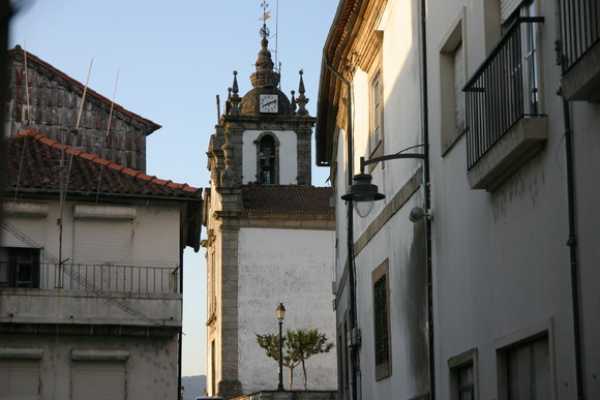
Espigueiros do Soajo
On the outskirts of the urbanized area. on a high point dominated by a great natural granite outcrop. there is a common threshing floor in the tradition of local communal living, flanked by 24 galaico-minhoto-style granaries, characterized by a low, elongated body and stone construction, forming a group classified as a Property of Public Interest since 1983. The canastros built in duck , primitive elements of these structures, disappeared completely. Some have an obvious sacralization, evident in the top crosses on peanhas, for divine protection of their contents, essential to the survival of the local community. The chronology of these architectural elements is integrable in the eighteenth and nineteenth centuries.
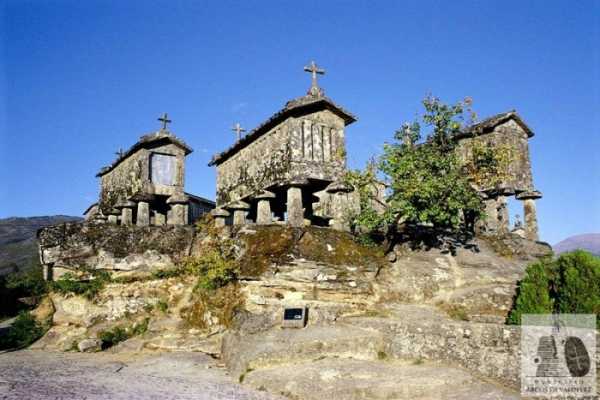
Eido da Peneda - Soajo
Lapa's Church

The worship of Our Lady of Lapa, of Beira origin, will have arrived in the village around 1758, and the temple will be completed in 1767. The church is characterized by the singularity of the architectural solutions that it shows, namely by the centralized plant, the tower behind the main chapel and, above all, a large, high dome, creating an innovative and simple solution. The ensemble, attributed to André Soares, is markedly Baroque. The interior, with three characteristic elements of carved carving at the level of the altarpieces and grids, is a typical example of rococo style.
Address: Largo da Lapa
Phone: +351 258 522 311
Email: parocoarcosdevaldevez@diocesedeviana.pt
Church of S.Bento
Located in a prominent elevation west of the village, the Church of S. Bento, whose work was completed in 1674, integrated an old monastery of Franciscan monks, of which today only the respective house remains, presenting a solid typology at the constructive level and a quantity significant collection of tile panels and diverse statuary inside, in a typical seventeenth century set.
Address: S.Bento
Phone: +351 258 522 311
Email: parocoarcosdevaldevez@diocesedeviana.pt
Church of the Matrix
The church was built at the mercy of Dom Pedro II on the foundations of an earlier, probably medieval, temple at the end of the 18th century. It is characterized by its particular interior richness, with notable examples of carved altars and paintings from the late seventeenth and the second half of the eighteenth century. In 1776 the Chapel of Calvary, located on the south side, was erected a remarkable element of sensibility, forming an artistic set clearly of rococo style.
Address: Praça Municipal
Church Misericórdia and Cruise
In 1595, the Confraria da Misericórdia was founded in the village, an event that promotes the construction of the first temple, which was completely rebuilt in 1710. The church has a longitudinal type plan with a frontal and richly decorated front and Baroque style, of some elements, such as the pulpit and choir, are already neoclassical. The cruise, located in the wide annex to the rear facade, area of the old cemetery, is an example of the eighteenth century composed of two steps, decorated base and capital with representations of the life of Christ, finished in cross.
Address: Largo da Misericórdia
Phone: +351 258 510 110
Email: geral@scmav.pt
Parish Church of S.Paio and escadaria
Its construction begun in 1781, it would be finished only in the 19th century. The building consists of the church building with a single longitudinal nave, a rectangular main chapel, a sacristy and other annexes on both sides. In the middle of the façade a bell tower is constructed, finished in a coruche and preceded by a significant staircase, in a set apparently influenced by the zone of the Port. The group of tiles that lines the exterior is dated from the 19th century.
Address: Rua Dr. Teixeira de Queiroz
Phone: +351 258 522 311
Email: parocoarcosdevaldevez@diocesedeviana.pt
Paço de Giela
The Paço da Giela is a remarkable example of medieval and modern private civil architecture. Its origin, like that of the ancient Castle of Santa Cruz, is deeply linked to the origin and formation of the land of Valdevez. When the castle ceased its activity as a strategic point. the building of Giela's "casa-torre" marks a new moment of protection and dominion and regal dominion over the area.
Currently the medieval tower is visible as well as the residential body with "Manueline" windows and fortified entrance. The tower was built in the mid-14th century. At the end of the XV century, beginning of the XVI, the area of residence is built, and was completed in 1573. In 1662 the Portuguese artillery causes serious damages in the building when expelling the Spanish general Pantoja. In the seventeenth and eighteenth centuries various changes were made in the housing body, starting from the nineteenth century a phase of decline and abandonment. In 1999 the property is acquired by the local authority. Classified as a National Monument since 1910.
Address: Giela
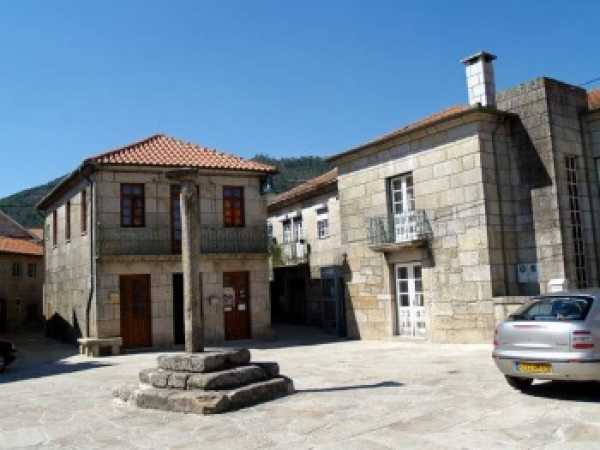
Pillory of Arcos de Valdevez
In 1515 D. Manuel I grants a charter to the village, a fact that drives the construction of the pillory. Until 1700 it was placed in the center of the Municipal Square, at which time it was changed to the riverbank, and later, in 1895, it was implanted in a square near the south facade of the Matrix. In 1998 it is placed in its current location. João Lopes is a singular specimen, with a torso and conical rock pillar, with a robust shaft rolled up by three columns, filled with a cup-shaped capital, decorated with national shields and armillary spheres. It is one of the few copies that shows the name of the engraved plot.
Address: Largo do Pelourinho
Pelourinho de Soajo
A National Monument since 1910, Soajo's pillory is a simple promontory on top, filled with an anthropomorphic face and a triangle at the top, reminiscent of a three-necked hat. The date of its construction is uncertain, although the charter given to the village by D. Manuel in 1514 can launch its construction, beginning its functionality of jurisdictional framework. Some authors interpret their sculptural elements as integrated into local traditions of administrative and political autonomy, but no reading is sufficiently precise in this respect. The fact that it does not have any slot for the placement of irons is indicated as justification for its late construction.
Address: Largo do Eiró - Soajo
Ponte de Vilela
Property of Public Interest since 1990, the bridge of Vilela is also symbolic of the architectural manifestations of this type existing in the rim of the county. It assures today the communication between the parishes of Vitela and Aboim, with a characteristic structure of access ramps and board in easel based on two arches, one of them broken, of uneven size, and prismatic talhamar.
The parapet is made of stonework, with the basal floor, irregular in shape, set directly on the arches' clasp.
Of typical Romanesque construction, and although the concrete date of its construction is not known, it appears referred to a toponym "bridge" in the Inquiries of 1258, which can suppose its existence already in the first half of century XIII.
Address: Sub Church Place
Bridge over the River Vez
The current bridge connecting the two banks of the village of Arcos de Valdevez is a nineteenth-century building, begun in 1876 and completed in 1880, which completely replaced a copy of medieval origin.
From this primitive construction there were no architectural elements left, so the knowledge of its original structure rests on a scarce bibliography and some engravings.
The monument was composed of four arches, rounded round, supported by strong pegões, without loops, and with talhamares. There were also two access ramps, which rose from the banks to a flat landing. No acronyms are mentioned in any of the stone elements of the building, although their existence was almost certain, as is characteristic in known examples of medieval bridges. The whole structure was markedly Romanesque. The period of its construction will be located somewhere between the end of the twelfth century, beginning of the thirteenth century, since in the Inquiries of 1258 the toponym "Arcos" appears already referenced.
The existence of the bridge and its association with the local fair, of significant size and importance in the fifteenth century, as well as an important road network to and from abroad, were the basis of the historical, economic and social development of the town of Arcos.
Address: Rua dos Milagres
The current bridge connecting the two banks of the village of Arcos de Valdevez is a nineteenth-century building, begun in 1876 and completed in 1880, which completely replaced a copy of medieval origin.
From this primitive construction there were no architectural elements left, so the knowledge of its original structure rests on a scarce bibliography and some engravings.
The monument was composed of four arches, rounded round, supported by strong pegões, without loops, and with talhamares. There were also two access ramps, which rose from the banks to a flat landing. No acronyms are mentioned in any of the stone elements of the building, although their existence was almost certain, as is characteristic in known examples of medieval bridges. The whole structure was markedly Romanesque. The period of its construction will be located somewhere between the end of the twelfth century, beginning of the thirteenth century, since in the Inquiries of 1258 the toponym "Arcos" appears already referenced.
The existence of the bridge and its association with the local fair, of significant size and importance in the fifteenth century, as well as an important road network to and from abroad, were the basis of the historical, economic and social development of the town of Arcos.
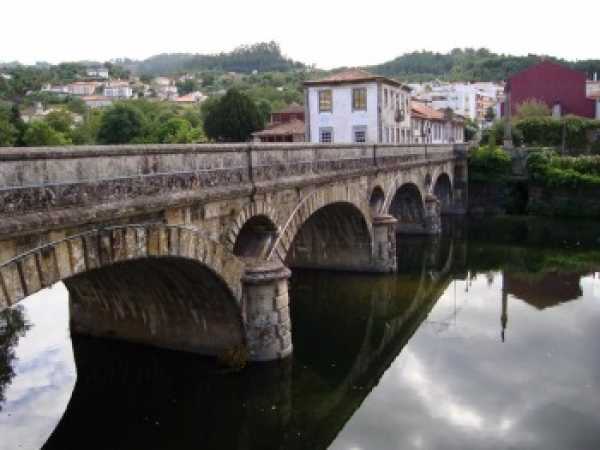
Monastery of Ermelo
The old monastery, probably built by D. Teresa, adopted the Cistercian order in the late thirteenth century, thus integrating the area under Santa Maria de Fiães influence. Evolving with immense difficulties, he was transformed into a parish church in 1441, returning to the order of 1497. In 1560 he was already in an advanced state of abandonment, so he is secularized, and his income is integrated into the college of S. Bernardo de Coimbra.
There are still some of the architectural structures of the Romanesque church and the subsequent changes made in the Modern Era. In its original form would be a church of three naves and bedside with three quadrangular chapels. Cister's original plan was not completed, probably due to economic difficulties of the local community, so what we see at present is mainly a result of the works carried out in the eighteenth century. The collateral nave was suppressed, leaving only the triumphal arch of the chapel (visible in the exterior), being on the opposite side adapted the sacristy. On the roof is visible one of the original elements of the Cistercian project, of important significance, composed by the Romanesque rosacea, illuminating element of the central nave. Some of the decorative elements of the canals and capitals are fully integrated into the Romanesque typical of the Minho basin, but the whole architectural plan of the work is exemplary of the typical model used by the order of Cister. In the south zone some arcades belonging to structures of the regular area of the monastery are perceptible.
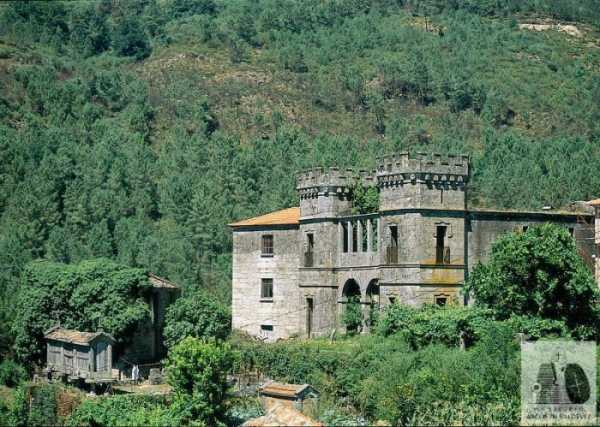
Megalithic core of Mezio
Integrated in the set of megalithic monuments known as "Antas da Serra do Soajo", the Megalithic Center of the Mezio incorporates about ten monuments, spread over a planar area of approximately 2 km, thus favoring the visit and consequent contact with unique specimens of these prehistoric funerary spaces built some 5000 years ago. The area includes three monuments scientifically intervened and later valued, the I Mamoas 1, 5 and 6.
The visitor who moves to the place has at his disposal informative graphic information on the studied monuments, allowing the understanding of the whole primitive architectural set, as well as of the areas valued under the global intervention. The megalithic nucleus of the Mezio is a rare case of importance, not only for the scientific information that allowed to harvest, but also for the recuperation and valorization patrimonial of such a remote and unique period.
Chapel of Our Lady of Conception
Address: Rua da Praça
Arcos de Valdevez
Chapel of St. John the Baptist of the Comenda de Távora
Address: Távora Santa Maria
Arcos de Valdevez
Bridge House
Address: Rua dos Milagres, 78
Arcos de Valdevez
Phone: +351 258 516 107
Email: casadaponteav@gmail.com
Sta. Cruz Castle + Castle Viewpoint
Address: Monte do Castelo - Vila Fonche
Cruise of the Lord of Miracles
Address: Rua dos Milagres
Eido da Peneda - Soajo
Paço da Glória
Address: Arcos de Valdevez
Portela - Jolda (Magdalena)
Phone: +351 258 947 177
Email: rfilling@hotmail.com
House of Arts of Arcos de Valdevez
Address: Jardim dos Centenários,
Arcos de Valdevez
Phone: +351 258 520 520
casadasartes@cmav.pt
Cistercian monastery of Santa
 EN
EN  PT
PT ES
ES FR
FR